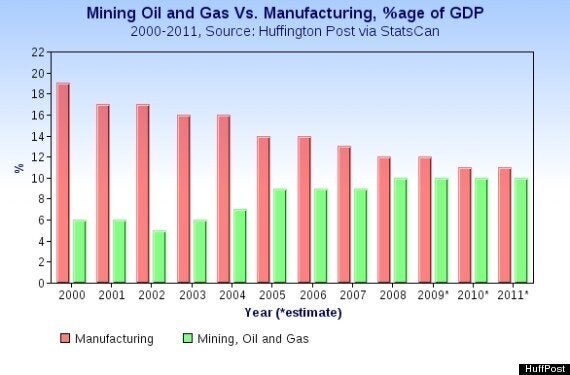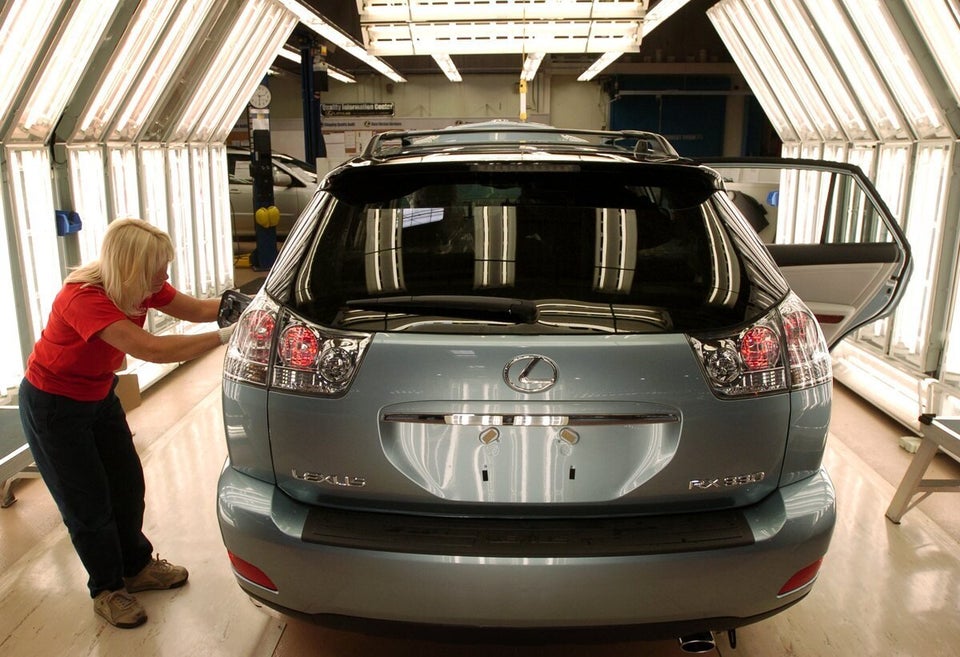
A new report from Bank of Montreal predicts that oil-rich Alberta will lead the country in economic growth this year, yet another confirmation of Canada’s growing dependence on natural resources to fuel its economy.
Most Canadians understand how the country’s industrial mix has shifted over the last decade to become increasingly weighted toward oil, gas and mining, for better or worse.
But data compiled by The Huffington Post reveal just how dramatic that economic pivot has been. With the help of a Statistics Canada analyst, HuffPost found that the dollar value of these three sectors has jumped an estimated 170 per cent in the last 10 years, to $163 billion from $60 billion in current dollar values — the steepest climb of any industry group.
(Calculations were based on Statistics Canada GDP data, which have been finalized through 2008. More recent figures are estimates, and are therefore subject to revision.)
The contribution of these industries to overall GDP in 2011 was less than finance, insurance and real estate at 19 per cent, and manufacturing at 11 per cent, but recent growth has been more impressive. As a share of GDP, finance, insurance and real estate held steady during the past decade, while manufacturing’s slice of the pie was eroded by almost half.

The rate at which Canada’s economic reliance on primary industries such as agriculture, bitumen and valuable minerals dug out of the ground has grown in recent years is also remarkable when compared to other industrialized nations, said Peter Jarrett, senior economist for the OECD.
Using a slightly broader definition to allow for international comparison of specific industrial categories, OECD figures show that, in 2008, nearly 15 per cent of Canada’s GDP was derived from primary resource extraction — the second-highest share among 34 OECD countries. Norway was the clear leader, with almost 28 per cent of its GDP coming from these sources, while Turkey (13.7), Mexico (13.2 per cent) and Australia (12.7 per cent), followed closely behind.
In most of these other countries, however, the reliance on primary resource extraction has remained relatively flat or fallen from 1990 to 2008, while Canada’s dependency on it has risen “fairly continuously,” Jarrett said.
“There’s clearly been an up trend. That’s mainly because of [commodity] prices,” he said.
While this growth is often broadly attributed to a wide variety of natural resources, as Natural Resources Minister Joe Oliver emphasized in a speech last month, the StatsCan numbers show that it has been almost exclusively contained to oil, gas and mining. Forestry and logging, crop and animal production and fishing, hunting and trapping accounted for barely one per cent of GDP each in 2011. While the value of crop and animal production grew about 44 per cent from 2000 to 2011, the forestry and fishing categories posted declines.
HOW CANADA'S INDUSTRIES FARED, 2000-2011
(STORY CONTINUES BELOW SLIDESHOW)
The boom in this specific resource category — and shift away from sectors such as manufacturing — reflects a combination of interconnected factors, such as growing demand for raw materials from developing countries, high commodity prices, the rising value of the Canadian dollar and a decline in the U.S. economy.
Some observers have argued that policy decisions at the federal government have amplified the shift. But Michael Burt, the director for industrial economic trends at the Conference Board of Canada said, “I’m not sure there [was] a master plan for that to happen.”
“Economic growth in the U.S. has been modest for five or six years now, and that’s not been the case with China and other developing countries. So it makes sense that our businesses are going where export opportunities are,” he said.
“Canada is one of the few countries with significant oil resources, no foreign controls. That’s a big part of it: We have the resources and we’re open to the development of them.”
Yet this shift has carried consequences.
While our recent exploitation of the commodities boom has made Canadians more affluent, Jarrett said it has the potential to be regionally divisive, concentrating wealth in resource-rich provinces, as evidenced by the BMO report.
“The nation clearly is better off, but it depends a lot on the details in the institutional framework whether or not any particular province is worse off or better off,” he said.
Another implication is increased economic volatility, which could be felt in the coming years as concerns mount over slowing growth in China, with some predicting a hard landing on the horizon for the developing Asian country.
Although only about four per cent of Canada’s exports are currently bound for China, BMO’s deputy chief economist Doug Porter said that “just looking at the pure trade numbers does not give the full sense of just how sensitive the Canadian economy has become to how the Chinese economy fares.”
“The real channel through which China affects Canada is the fate of commodity prices,” he told HuffPost after a speaking engagement in Toronto last month.
While there are still other countries that are more vulnerable than Canada to China’s economic trajectory, he said, “the Chinese economy has a much bigger say in how the Canadian economy fares than it would have five or 10 years ago, there’s no question about that.”
Despite this risk, Porter, who is not forecasting a hard landing in China, said there is no real alternative to staying the course.
“If anything, [Bank of Canada] Governor Mark Carney has urged Canadian business to reorient themselves away from the U.S. and actually go to where the growth is, and I think that’s appropriate advice,” he said.
